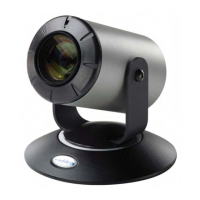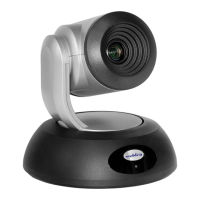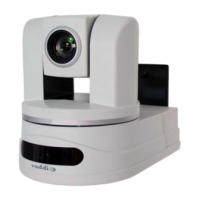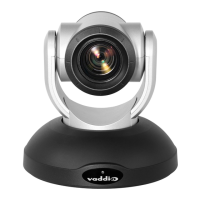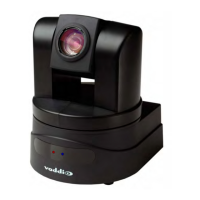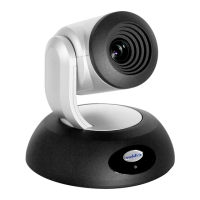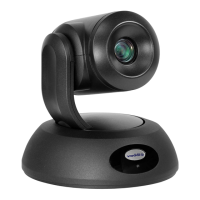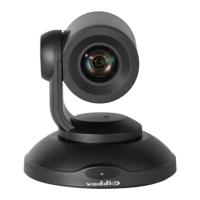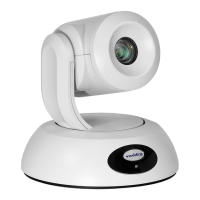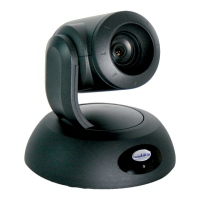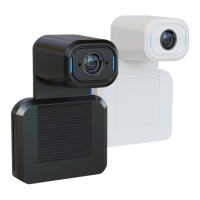
Do you have a question about the VADDIO IntelliSHOT 999-21100-000 and is the answer not in the manual?
| Brand | VADDIO |
|---|---|
| Model | IntelliSHOT 999-21100-000 |
| Category | Security Camera |
| Language | English |
Lists the main topics and sections covered in the manual.
Details the key capabilities, specifications, and benefits of the IntelliSHOT camera.
Describes the physical appearance and components located on the front of the camera.
Details the RJ-45 connector for network and power delivery via PoE+.
Explains the USB Type B connector for computer connectivity and data transfer.
Describes the HDMI port for video and audio output.
Covers site selection, readiness verification, and essential preparation steps before installation.
Details installing the camera mount, connection diagrams, and cabling best practices.
Highlights specific cautions to avoid voiding the product warranty during installation.
Lists the web browsers that have been tested for device setup compatibility.
Outlines the different approaches available for initial device setup and configuration.
Guides through the initial setup process using the Vaddio Device Controller tablet.
Explains how to access the camera's web interface directly via its IP address.
Describes the final steps required to complete the initial device configuration and setup.
Covers setting admin passwords, user access levels, and other IT security-related settings.
Guides on configuring a static IP address for reliable network connectivity.
Explains how to change the camera's network hostname for easier identification.
Covers setting the time zone and NTP server for accurate system timestamps.
Describes adding room details and labels to the camera's web interface.
Covers tuning the camera's auto-tracking behavior, including sensitivity and speed.
Details settings for video and audio streaming via USB and IP protocols.
Explains PTZ controls, color, lighting, and focus adjustments for manual operation.
Covers microphone and speaker settings, including echo cancellation.
Explains how digital pan, tilt, and zoom functions operate within the Autoframing system.
Covers setting optical zoom and selecting predefined Autoframing configurations.
Details adjustments for motion detection sensitivity and noise tolerance.
Covers persistence, responsiveness, and speed adjustments for fine-tuning tracking behavior.
Details buffer zone, Tri-Sync Motion, and forced wait time settings for motion handling.
Introduces the audio settings interface and basic mute/volume functions.
Details settings for microphones, speakers, echo cancellation, and audio referencing.
Covers viewing and configuring USB video streams for compatibility with soft conferencing applications.
Guides on viewing IP streams using protocols like RTSP with media players.
Covers simple IP streaming setup using default quality and resolution settings.
Details advanced customization for IP streaming parameters like bit rate and resolution.
Guides on setting up RTMP streaming for content services like YouTube.
Explains MTU settings, advising consultation with network administrators for changes.
Covers configuring the camera's home position and saving camera shots as presets.
Details how to rename presets and custom CCU scenes for better identification.
Covers adjusting pan, tilt, and zoom speeds for manual camera control.
Explains how to configure the direction of camera movements for remote control.
Explains using predefined and custom CCU scenes for lighting and color adjustments.
Details manual adjustments for iris, gain, detail, chroma, and gamma settings.
Offers guidance on adjusting color vividness, white balance, and tint.
Explains how to save custom color and lighting adjustments as scenes for later recall.
Covers settings for LED indicators, including on/off and color schemes.
Details point light compensation, HDMI color space, and video output resolution settings.
Explains UVC mode for USB streaming and enabling far-end camera control.
Describes controlling the camera's functions via the web interface.
Explains how to mute audio/video and manage the camera's standby power state.
Details camera movement via manual pan/tilt controls and recalling preset positions.
Covers installing batteries and pairing the RF remote control with the camera.
Provides a quick guide to the buttons and features of the RF remote control.
Offers tips on common remote behavior, pairing scenarios, and troubleshooting.
Details exporting and importing camera configuration settings for backup and recovery.
Guides on downloading and installing firmware updates to maintain camera performance.
Explains how to restart the camera system to resolve issues or apply updates.
Provides contact information for Vaddio technical assistance and support resources.
Explains how to access and interpret diagnostic log files for troubleshooting.
Details prerequisites, connection methods, and usage notes for the Telnet API.
Explains how to retrieve command information and details typographical conventions for syntax.
Lists command types for status, shot definition, and behavior adjustment.
Details the command syntax for enabling or disabling the Autoframing feature.
Explains the command to pause or resume Autoframing, enabling manual control.
Details commands for controlling the camera's optical zoom level.
Explains settings related to the buffer zone in the Autoframing system.
Details settings for the shot margin, controlling the framing tightness.
Covers adjusting the camera's sensitivity to motion for Autoframing.
Details adjustments for how quickly Autoframing reacts to new motion detection.
Explains the setting for how the camera remembers initial motion when Autoframing starts.
Covers how long the camera remembers motion and stays on its source.
Sets the limit for maximum electronic zoom during Autoframing.
Limits the maximum pan, tilt, and zoom speed during Autoframing.
Adjusts the minimum change recognized as motion for Autoframing.
Enables smooth pan, tilt, and zoom for Autoframing movements.
Sets a minimum time to hold the shot before responding to new motion.
Moves the camera to its home position and zoom level.
Controls the horizontal movement (pan) of the camera using specified commands.
Controls the vertical movement (tilt) of the camera using specified commands.
Controls the camera's zoom level, moving the view in or out.
Sets a specific shot by defining zoom and precise pan/tilt coordinates.
Manages camera positions and settings saved as presets for quick recall.
Details how to set auto-focus or manual focus for the camera.
Manages CCU scenes, allowing recall of factory or custom settings.
Gets current CCU (lighting and color) information from the camera.
Controls the camera's status indicator lights, including on/off states.
Mutes the camera's video output, displaying a blue or black screen for privacy.
Puts the camera into a low-power standby state to conserve energy.
Gets or sets the volume for specified audio channels like microphone or speaker.
Mutes or unmutes specified audio channels, including master mute.
Manages echo cancellation status for the internal microphone to prevent audio feedback.
Retrieves current network settings and MAC address of the camera.
Controls the enabling or disabling of IP streaming for video output.
Returns current IP and USB streaming configuration details and parameters.
Retrieves the current firmware version of the camera for system status checks.
Sends ICMP ECHO_REQUEST packets to test network connectivity and latency.
Explains how to restart the camera system immediately or after a specified delay.
Manages the status for resetting the system to factory defaults upon the next reboot.
Accesses command history, help syntax, and exits the Telnet session.
Addresses common issues related to power, cables, and remote control functionality.
Solves issues related to IP streams, USB streams, and overall video quality.
Addresses problems with speaker audio, microphone input, and echo cancellation.
Explains the meaning and states indicated by the camera's status indicator lights.
Guides on restoring the camera to its original factory settings through the web interface or IP button.
